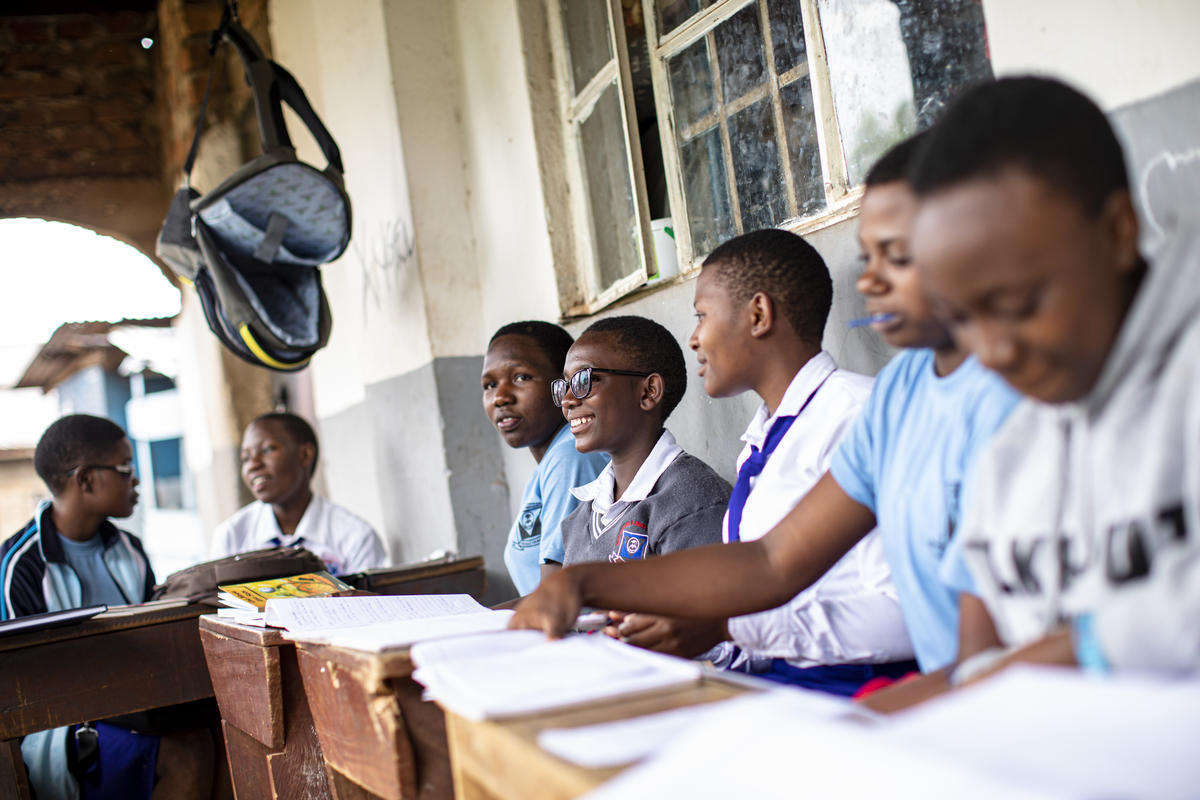Enhakole fled Rwanda in 2010 with her mother and siblings to seek refuge in Uganda. Born with a visual impairment, she received support from Educate a Child and UNHCR and completed her primary education. She now attends secondary school with the dream of becoming a doctor. © UNHCR/Antoine Tardy
By Nina Papadopoulos, Senior Education Officer, UNHCR
Celebrating the International Day of Education in 2024 is a time to do more than just mark a date in our calendars. This day embodies a narrative of resilience, hope, and advancement, particularly poignant for the countless refugee children and youth navigating obstacles to access education. Highlighted during the Global Refugee Forum (GRF) in December 2023, education remains crucial in disrupting the cycles of conflict and displacement, a goal achievable only through global solidarity and cooperation. In this context, UNHCR takes a moment to reflect on the collaborative efforts and strategies that have successfully dismantled barriers, enabling refugees to access basic education alongside their peers in host communities.
Start with support for teachers
“You can teach without a classroom, but you can’t teach without a teacher”
Teachers are the backbone of the education system, especially in crisis situations. Ensuring continuous professional development and assistance to teachers is essential to creating a safe and encouraging learning environment.
As detailed in the GRF pledging teacher guidance, providing predictable and multiyear financing for teacher compensation, recognition of prior qualifications, and access to professional development and career pathways remain vital. In Malawi, a Memorandum of Understanding (MoU) is being developed to register the camp-based schools within the national system so that refugee teachers will be included on the national payroll and have access to training and pathways to professional qualifications.
Bridge the gap to secondary education
While primary education sees higher enrolment, secondary education remains a crucial yet often missing piece in the educational continuum for refugees. In the 2023 UNHCR Education Report, the disparity between primary and secondary education enrolment rates stood starkly at 65% and 41%, respectively.
To address this disparity, UNHCR initiated a pilot secondary education initiative in Ethiopia, Iraq, and Pakistan, targeting specific challenges in secondary education particularly for girls. From establishing baby care centers to facilitate teenage mothers’ retention in school to supporting adolescents’ boys’ and girls’ clubs and improving educational infrastructure, these efforts are contributing to improving secondary education access and attendance. This, coupled with Inter-agency efforts such as the Secondary Education Working Group (SEWG) and strong commitments on secondary education at the GRF, provides a basis for strengthening secondary education provision for refugees.
Innovate beyond technology
The outbreak of COVID-19 called for rapid and decisive action to adapt to the dramatic changes across the education landscape, ensure learning continuity during school closures and preparation for the safe reopening of schools. Although the pandemic exacerbated the digital divide facing refugee communities, school communities demonstrated extraordinary, creative innovations that ultimately improved education access for and inclusion of refugees. This included devising and adopting flexible education modalities through digital or interactive TV and radio broadcasting lessons, take-home packages, small-group learning, or home visits.
If the COVID-19 crisis has taught us a lesson, it is that innovation does not necessarily have to be digital or involve technology but is rather a matter of small details and adaptations leading to significant transformations and improvements. Rwanda’s example of aligning educational technology hardware with national reforms and providing access to relevant curricular materials demonstrates that innovation is often rooted in simplicity and user-centred design yet can lead to substantial improvements.
Include refugee students in national education systems
Significant progress has been made in including refugees in the national education system as envisaged in the Global Compact on Refugees (GCR). This success is attributed to strong collaborations at various levels, which have facilitated curriculum transitions and the registration of camp-based schools. Notably, the Refugee Education Integration Policy (REIP) in the Kurdistan Region of Iraq and the transitioning of camp-based schools to new curriculums in Kenya and South Sudan are milestones in this journey. Rwanda, Cameroon, and Mexico’s approach to integrating refugees into public schools alongside nationals is a testament to what can be achieved through inclusive policies. These inclusion examples provide critical steps in ensuring that refugee children are not just receiving an education but are also integrated into the broader societal fabric, promoting a sense of belonging and community that is vital for their long-term well-being and success.
As we celebrate the International Day of Education this year, let’s acknowledge the strides made in refugee education while recognizing the journey ahead. Each challenge overcome is a step toward a world where every child, regardless of their circumstances, has access to the transformative power of education. This day is not just about reflection; it’s a call to action for continued commitment to the education of refugee children. The journey towards inclusive and accessible education for all, including refugees, is ongoing, and our collective efforts can make a significant difference in shaping a brighter, more equitable future.

